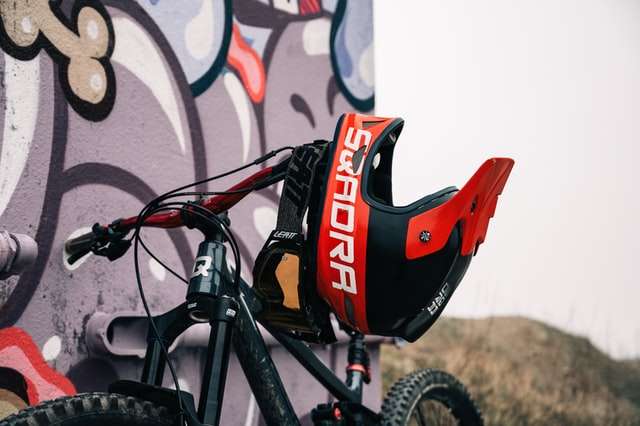Even a biking novice will immediately notice that mountain bike helmets look different from road bike helmets. Yes, MTB helmets are bulkier at the back, but really their most visual difference is that they have visors.
So, why is there a need for a visor on mountain bike helmets? A simple answer is that a bike helmet visor protects from the sun and other natural elements on different trails and terrains.
But, there is more to this protruding piece of equipment and how it helps mountain bikers. Read on to find out what makes visors on MTB helmets so crucial and the type suitable for you.
Why do MTB Helmets Have Visors?

If the only reason a mountain bike helmet came with a visor was protection from the sun, then the rider could technically get away with just wearing sunglasses (that’s what you do when wearing road bike helmets). So, naturally, there are other advantages of a visor sticking out of your mountain biking helmet.
Below I discuss five substantial benefits of visors on mountain bike helmets.
1. Protection from Natural Elements
So, why do mountain bike helmets have visors? Essentially, the biggest reason is to shield the riders’ eyes from the sun. But that’s just not it. The helmet visor will not only save you from harsh sunlight but other elements like rain and snow.
The visor does not hinder the forward view since mountain bikers have more of an upright sitting position than road bikers. Moreover, you get similar protection from rain and snow, especially if the weather catches you unprepared. Win-win!
Related post: MTB in the Rain
2. Acts as Shield Against Low Hanging Branches
Another reason mountain bike helmets have visors is that often mountain bike trails have a few low-hanging branches that can be a big distraction. When you cannot duck away from such trail obstacles on narrow single-track trails, a visor extending from your helmet acts as a shield, helping deflect such objects as you focus on riding the bike safely.
This also helps you retain better balance as you ride a mountain bike because you do not have to resort to shielding your face with one arm and can look straight ahead.
3. Shields Against Dirt and Mud Splashes
A mountain bike helmet visor also protects riders against mud and dirt flicked from various trails or the wheels of a rider in front of you.
4. Lessens Impact During Crash

Bike helmets (and visors) save lives. The main reason people wear mountain biking helmets, or any other kind for that matter, is to be protected in case of falls and crashes. When mountain biking, crashes will happen- A LOT – and a visor can distribute the shock evenly from the point of impact throughout the helmet, often preventing severe head injuries. The visor will most definitely break, but it will also break your fall, which matters the most.
Related post: How dangerous is mountain biking really?
5. Acts as A Cycling Accessories Mount
Bike helmets have visors for another reason, apart from prevention and protection: they are great for mounting goggles’ strap clips and other cycling accessories like a POV camera, goPro and light for navigating dimly lit trails at night.
What is a Visor Exactly?
By now, you probably have a pretty good idea of what a visor is, but to define the term, let me reiterate.
A visor is a part of a helmet that extends from the frame or can be pulled down to protect the rider’s eyes from the sun and rain. From mountain bike helmets to cycling helmets, you can find various visors that protect the rider from natural elements, often serving as an added layer of security during a bike ride.

However, their shape can cause considerable wind drag, which is why you will not see them featured on-road bike helmets, where speed matters the most.
Types of Mountain Bike Helmet Visors
Mountain bike helmet visors come in various types. Here is all you need to know about them.
Fixed Visors
As the name suggests, fixed visors are built into the helmet. They are usually molded into the mountain bike helmet body, making them stay in their place with no movement. While sturdy, this visor kind is no longer as popular as their lack of adjustability means they have to be pretty narrow to provide a good view of the trail.

Primarily, a helmet visor protects against sun glare, but this type of narrow visor lip does not ultimately allow that. Thus, fixed visors often feature on budget-friendly mountain bike helmets, like a BELL Spark MIPS Adult Mountain Bike Helmet.
Adjustable Visors
Often found on a high-end bike helmet, an adjustable visor extends much further than its fixed counterpart. Such visors are attached to the mountain bike helmet by screws on both sides. These have much better functionality as the further extended lip allows the necessary protection with the option to move them out of the way when they are not needed.

Overall, adjustable visors are much broader than the fixed design and thus, provide much better protection. The Giro Chronicle is one of the many pricier mountain bike helmets with adjustable visors.
Detachable Visors
Depending on the type, both fixed and adjustable visors can be detachable. If fixed, with the help of screws, you can easily remove the visor for deep cleaning or when you do not intend to use it.
Apart from screws, a detachable visor can be fixed on a helmet via snap-in plastic bands or strong magnets. You will find snap-on detachable visors on cheaper helmets, which often lack the durability you look for in such a piece of equipment.

Also, a removable visor also works well for people who do not intend to buy a different road bike helmet and plan to use the same one for all kinds of biking.
I am a big proponent of using special safety equipment like helmets as instructed (there is a reason why a professional mountain biker would not wear a road biking helmet). However, if you want to use the same helmet for mountain and road biking, a detachable visor is the way to go.
Related post: Can you put a basket on a mountain bike?
Pros & Cons of MTB Helmet Visors
I have already discussed various benefits of using an MBT helmet with a visor. However, depending on your situation, there can be a few downsides to it as well.
Pros
- Protection against sun, rain, and snow
- Shielding from small branches and twigs
- Prevents dirt, debris, and mud splashes
- Protection during crashes and falls
- Used for mounting equipment for various cycling accessories

Cons
- Can catch leaves when shielding from branches
- Adds weight to the helmet
- Difficult to see when going downhill in a crouch position
- Slows you down (mainly an issue for cross-country mountain bikers)
However, the cons do not outweigh the benefits of wearing a mountain bike helmet with a visor, which gives you a much-needed added security layer.
Suggested post: Are foldable bikes safe?
Can you Add a Visor to your MTB Helmet?
If your helmet visor is broken or has come off, you can easily order a replacement for the particular model by calling the manufacturer or online. However, if your helmet did not come with a visor initially, you may have to make do with flexible visors that attach using Velcro or some adhesive. Mind you, these add-on options are not very sturdy or long-lasting.
How to Attach a Visor to an MTB Helmet?
A visor can be attached to an MTB helmet in numerous ways, but not all of them will yield the same result in terms of durability. MTB helmets either come with a fused visor that does not move or have slots and screws for putting one on.
Here are the three most popular ways a visor can be attached to a mountain bike helmet.
Molded in Place
If the visor is molded in, you do not technically have to attach the visor as it already comes fixed in place. With this attachment style, a visor does not change its position.

Screw the Visor in Place
Most high-quality MBT helmets have screws to attach visors in place. The screw attachment is often used for adjustable visors, which are bigger and thus, provide better protection. Visors attached with screws can also often be removable for easy cleaning and prove to be much more durable.
Snap The Visor On
Some visors can also be snapped on the helmets. However, they often do not provide much support.
Related post: Full face vs Open face MTB helmets
Do you Need to Use a Visor Every Time?

I recommend using a visor every time you take out your mountain bike. While some people find it uncomfortable or may not require it on flatter surfaces and broader trails, it is still essential for protection against sun and bad weather conditions. A good compromise is to use an adjustable visor that can be moved out of the way if not needed.
Conclusion
Mountain bike helmets have visors to protect from natural elements like sun, rain, and snow, which often hinder a biker’s view. They also prove helpful in shielding the biker from trail obstacles like twigs and branches. With an MTB helmet visor, you stay protected from debris and mud while also being able to mount various accessories on it. All of these safety benefits make visors a necessity for mountain bikers.


